|
|
|
This
text is taken from the script for an interpretive
program that Muin’iskw used to give at Kejimkujik
National Park around 2005. These programs were done in
the form of slide shows, and I have added slides similar
to the ones she used for her actual presentation. In
effect, this will be like having attended her program in
real life. |
|
|
|
|
 |
The north-eastern region of North America,
which includes the Maritimes provinces, Newfoundland, the Gaspe
Peninsula of Quebec, and into northern Maine, has been home to
my Ancestors, the Mi’kmaq people, since time immemorial. The
Mi’kmaq divided their territory into seven districts; the
south-western portion of Nova Scotia was known to them as
Kespukwitk, or “Land Ends.” |
|
|
|
 |
Situated in the center of this district is one
of the larger natural lakes. This lake was known by the early
Mi’kmaq as Cegumcaga Lake. Over time, the name of the lake
changed to Fairy Lake, and eventually it became known as we know
it today: Kejimkujik Lake. |
|
|
|
|
|
|
 |
The Kejimkujik area is characterised by an
interconnected network of lakes, rivers, and streams, all
surrounded by rolling hills and beautiful mixed forests. It’s in
this tranquil setting that one can get a strong sense of the
First Peoples’ presence, and a rich history of traditional land
use. |
|
|
|
 |
The waterways provided an extensive
transportation system that the Mi’kmaq used as a regular part of
their semi-nomadic lifestyle, regularly moving between the
coastal areas and inland during the seasonal changes, in search
of food and other resources. |
|
|
|
 |
Kejimkujik has been a National Park for more
than three decades, yet its importance to the Mi’kmaq is based
on millennia of Ancestral history. The oral traditions tell of a
continuous presence here since time immemorial. Documentation of
various aspects of the history of Kejimkujik has taken place
since the mid-1800s, which has increased our knowledge and
understanding of how the Ancestors once lived here in
Kejimkujik. We now know that the Ancestors left an invaluable
imprint upon this place. Through careful research and
documentation, numerous ancient sites dating back as far as 5000
years have been identified here in the park. This includes
remnants of seasonal campsites, fish weirs, numerous trails and
portages, and burial grounds. Our Ancestors also left us with
another legacy: the many islands, rivers, and lakes within
Kejimkujik still bear names that are of Mi’kmaw origin. |
|
|
|
 |
But perhaps the most distinctive evidence of
early Mi’kmaq presence is the written historical records which
have withstood the test of time. These are the records of a
historical journey of our people, carefully etched upon Mother
Nature’s blackboards: the slate outcrops found along the shores
of Kejimkujik Lake. These slates originated millions of years
ago as sedimentary beds, eventually transformed into slate beds
and tilted almost vertically to the surface. During our last
glaciation period, approximately ten thousand years ago, these
tilted slate beds were scoured and polished to produce smooth
cross-sections of the bedding surfaces. Today the outcrops lie
close to the ground, following the gradual slope of the land
into the water. Part of the year our water levels are high, and
only small areas of these slates are visible. As the water
levels drop - usually by mid-summer – large expanses of these
rocks appear, showing off their smooth surfaces. It is on these
surfaces that the ancient writers took advantage of the
smoothness and softness of the slate, which allowed the artist
to easily mark on the surface. |
|
|
|
 |
At first glance it’s not obvious that there is
anything special about these slate outcrops along our shores.
However, if one takes a closer look they may see one of the many
unique images which were placed upon these rocks by the early
Mi’kmaq people centuries ago. The images were either incised
(carved) or pecked (chipped) into the rock, using various types
of tools made from stone or bone. I refer to these images as
kunntewi’kaqn (goon doe WEE gah en) which literally means
“writings on stone”. Today they are commonly referred to as
petroglyphs. There are approximately 500 different petroglyphs
within four main sites here in Kejimkujik, making this the
largest collection of such imagery in eastern North America. |
|
|
|
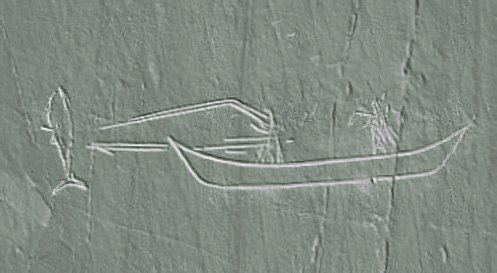 |
The initial appearance of a freshly carved
petroglyph would have been quite noticeable, with its white
lines starkly contrasting with the dark slate. Over time, these
images have weathered, and their lines have slowly faded back to
the original colour of the rock, blending with the natural
cracks and abrasions which cover the rock surface. |
|
|
|
 |
Today these images are difficult to see, and
usually impossible for the untrained eye to distinguish from a
distance of more than two or three feet away. However, despite
their faint and fragile existence, these are a valuable and
irreplaceable link to our Mi’kmaq Ancestors, who knew these
woods and waters long ago. |
|
|
|
 |
So why did the early Mi’kmaq people carve
imagery into these rocks along the shores of Kejimkujik?
Unfortunately, we do not know all the reasons why these images
were done. However, there is no doubt that the majority of these
images indicate the passing on of information: perhaps the
documentation of important events which took place here in
Kejimkujik; possibly a telling of stories, legends, or myth; or
maybe it was a teaching being passed down from an Elder to a
child. Keep in mind, though, that some of the petroglyphs may
only have been doodling, at the time they were done. |
|
|
|
 |
These images cover a wide variety of topics
and form a rich store of information about early Mi’kmaq life
here in the Kejimkujik area, depicting many aspects of the
lifestyle of a semi-nomadic culture. This evening I want to
share with you some of my knowledge about the petroglyphs. I
have been honoured and privileged to have had the opportunity to
learn about these images for many years, and it is important to
me that I share what I know, not only with my people, but also
with any who are interested. At the same time, I want to share
with you some of the stories behind them. |
|
|
|
 |
One of the most numerous types of images are
those that represent the human form. Well… some of these are
indeed human figures, but some may well be figures of beings
other than human, as we’ll see a little later. The interesting
thing about the human figures is that the majority of them are
of an hourglass shape. This is a unique feature of the Mi’kmaq
petroglyphs, where human shapes are depicted in a symbolic way,
rather than realistically. |
|
|
|
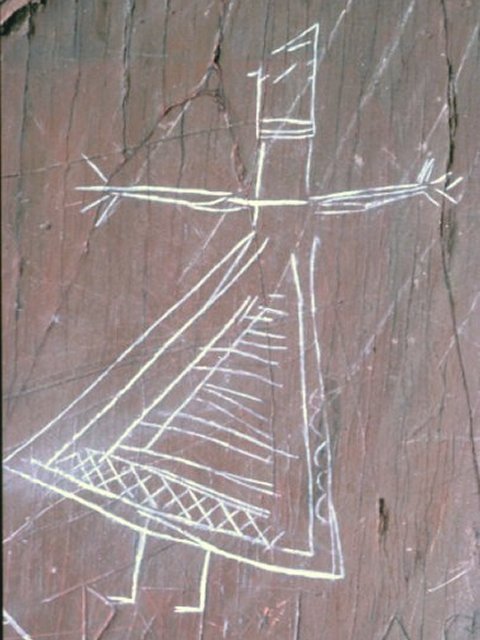 |
This is nukumi’ (NOO goo mee - grandmother) as
I call her. This image is used today by our Mi’kmaq artists, and
you find her on book covers and such. |
|
|
|
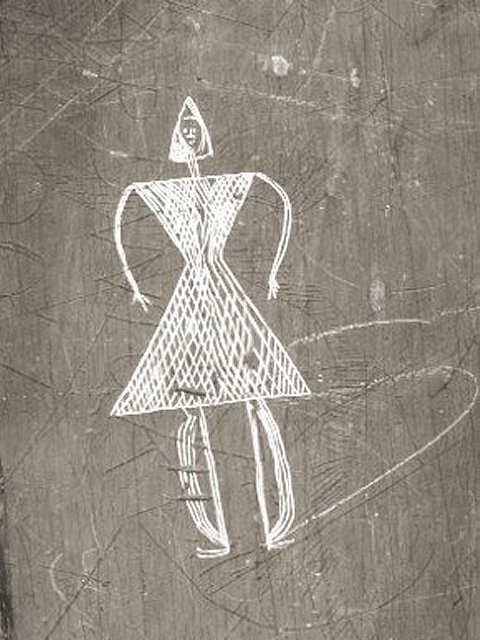 |
This young lady is our very own Mi’kmaq
Cinderella, who got dressed up in a birchbark dress and leggings
that she made and her father’s old moccasins to see if she could
win the heart of the handsome legendary Invisible Hunter.
(note: see story
here) |
|
|
|
 |
Also in our collection we have an assortment
of hands and feet. Many of these hands and feet are drawn with
representations of flexion lines and prints. This one here has
two hats in the palm area. One is the peaked hat of a woman, and
the other is a man’s hat. Perhaps the artist who did this image
did an outline of his hand, and placed the two hats in the palm
to represent himself and his wife. |
|
|
|
 |
This hand the size of a six or seven year old
child, yet it is an adult hand. The story behind this image says
that, a long time ago, a Medicine Man from the west direction
came to our people at a time of great sickness. He was only
about four feet tall, yet he was a strong Medicine Man. He cured
many people, and before he left to go back to his homeland, he
went to one of the petroglyph sites and knelt down to give
thanks to our Creator for giving him medicine to help people. As
he knelt down he placed his one hand on the rock. Because of his
strong medicine, he left an imprint on the stone. Someone then
came along later and carved the outline of the hand.
(note: see story
here) |
|
|
|
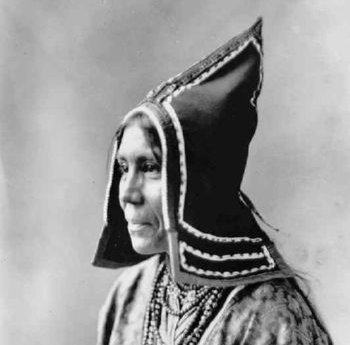 |
At least 61 petroglyphs depict the woman’s
peaked hats. This style of hat is unique to the Mi’kmaq, and is
not found in any other North American culture. These images were
often carved with intricate decorative detail. |
|
|
|
 |
The peaked hat is one of the most common
images on the rocks, indicating the importance of the peaked hat
in the Mi’kmaq culture. Indeed, these hats were considered so
sacred that men were forbidden to touch them. The number of
images also suggests to me that there was an intriguing link
between the women and the slate outcrops. |
|
|
|
 |
This is the largest peaked hat we have… |
 |
|
…and these are some of the smallest ones,
which are the size of a dime. |
|
|
|
 |
Also on these rocks are representations of
pure design elements. This one here is the largest piece of
decorative art; I refer to this one as the Mawi’omi (mah wee OH
mee), a representation of a Gathering of the people from the
seven districts who would come together on an annual basis to
discuss hunting territories and social conditions of the various
districts, to arrange marriages between families, and above all
to discuss the well-being and protection of the people. During
the time the men were sitting in discussions, women would be
busy preparing for the celebrations and feasting. Some women may
have been recording these activities, as this image suggests. |
|
|
|
 |
Also, I have learned that curvilinear designs
are representations of our journeys in life. In some instances
our journeys have two paths, the path of our physical life and
our spiritual path. |
|
|
|
 |
Animals were very important to the people.
Their spirits could be called on by the people in times of need
for feed, medicine, or guidance. Before a hunt a ceremony would
have been done by the hunter, to ask the animal spirit to give
its life so that the people could live. |
 |
|
|
|
 |
Once the animal was brought down, another
ceremony would take place to free the spirit of the animal so
that it could come back again. Animal spirits were also called
on for protection and strength. |
|
|
|
 |
Hunting, fishing, and gathering were
definitely an important part of the everyday lives of the
people. Here we see a caribou hunt scene. Caribou were once
plentiful in this area, and it is said that the last caribou
hunt was carried out here in the late 1800s. There is still an
Elder alive today who can tell the story of his grandfather
hunting caribou here in Keji. |
|
|
|
 |
Here is a fishing scene. This slide shows the
porpoise hunt. This, of course, was an activity that took place
along the coastal areas, as we do not have porpoises here.
Perhaps the person who was fishing one summer came to Keji, and
told his story of a plentiful summer. |
|
|
|
 |
Here we have a small whale hunt, again an
activity along the coastal waters. |
|
|
|
 |
One interesting point that should be mentioned
is that we don’t see a lot of images of plant life. Yet plants
were just as important to the people as animals, fish, and
birds. Plants were sources of both food and natural medicines.
Strangely, there are very few images among the petroglyphs |
|
|
|
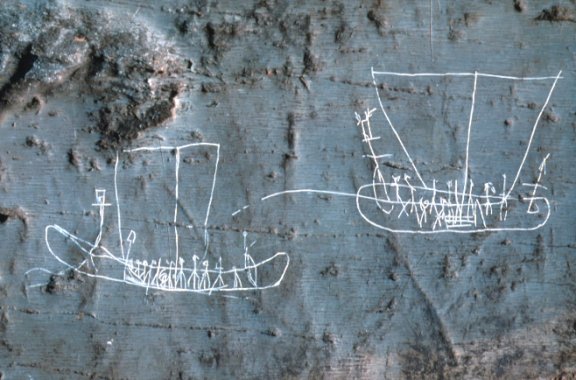 |
As a major form of transportation, the canoe
is represented in 28 images. Many of these clearly show the
distinctive form of a Mi’kmaw canoe. The unique high gunwales
and sails made it suitable for seagoing travel. |
|
|
|
 |
In a story I was told, during the annual
gatherings of the people, they would travel from far distances,
crossing large bodies of water such as the Bay of Fundy,
crossing the ocean to the state of Maine, and even as far as
Newfoundland. |
|
|
|
 |
I started off this evening talking about the
human shape images, but not all of the human shapes are
representing people. Actually, some of these images are of
supernatural beings. In our culture, we believe that there are
four races of Little People: the Putlatamu’j (boo dah LAH dah
mooj – at right,) the Ni’kmwesu (nee gum weh soo – at left,) the Salstoq (sahl stoh,) and the Puktewsatulkwultiji’k (book toe sah
dool GWOOL dee jeek). The Salstoq spoke the old Mi’kmaw
language, but they never wanted to be civilized. The
Puktewsatulkwultiji’k are the “people who smoke,” and they are
red and are a very small race. |
 |
|
|
|
 |
Place yourself in the past, sitting upon a
rock beside a storyteller who is patiently carving an
illustration as he re-tells the legend of the great Kulloo (GOO
loo) bird, who granted special magical powers to the successful
Mi’kmaq hunter who caught it. |
|
|
|
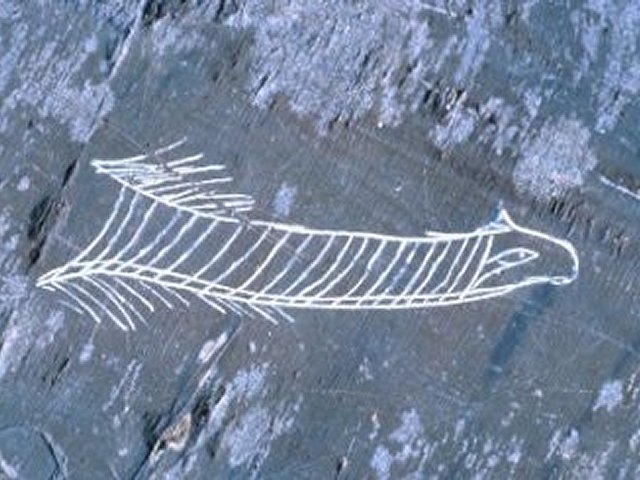 |
Then there is the Great Horned Serpent, who is
believed to inhabit the lakes here in Keji. Legends tell how the
Horned Serpent would take young Mi’kmaq men, marry them, and
take them back to their underwater world. In the same way, every
year as the water levels rise towards the winter, the petroglyph
of the Serpent returns to her home beneath the waves. |
|
|
|
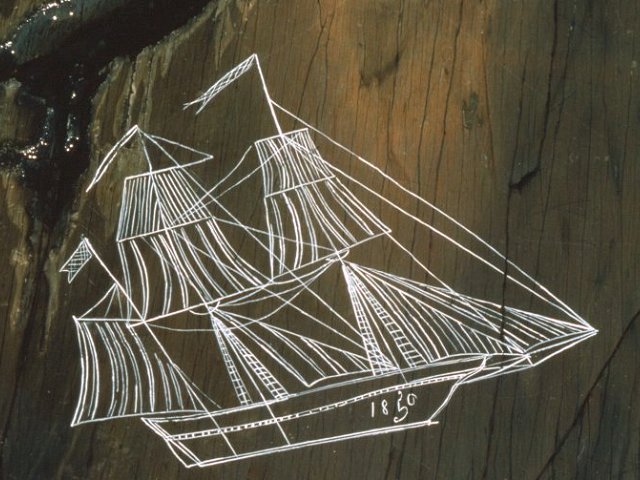 |
Ships inscribed on our rocks tell the story of
changes in the lives of our Ancestors. There is a petroglyph I
know of which tells the story of the coming of the Europeans. In
this petroglyph it was told that this race would arrive in the
night, and with them they would bring a new religion to the
people, forever changing their lives. |
|
|
|
 |
This new religion was Christianity. It is said
that the first Mi’kmaw that was baptised into the Catholic
religion was Grand Chief Membertou and his family. The baptism
took place at Port Royal in 1610. Membertou is said to be over
100 years old when he was baptized. |
|
|
|
 |
As time progressed and changes took place, my
Ancestors began to learn the ways of the Europeans. They also
learned to read and write, and today we find some names of those
early people inscribed upon the petroglyph sites. |
|
|
|
 |
The images I have shown you are only a glimpse
of the past. These are invaluable records of the historical
journey of the people. Unfortunately time has seen an
accumulation of damage to these fragile records. Without a
doubt, the devastating effects of weathering, erosion, and human
impact are the major factors which have directly affected the
condition, and the very existence, of these images through time.
The fragile nature of these sites cannot be stressed enough.
Just to give you an idea of how delicate these images are,
simply walking on these outcrops wearing shoes will cause
surface damage that could be the final ‘step’ in obliterating an
important message. |
|
|
|
 |
Human impact has certainly left its mark on
these special sites over the years. Unfortunately these sites
have even been subjected to vandalism. Many visitors over the
years have intentionally or unintentionally defaced a lot of the
images. There is an understandable temptation to leave one’s
mark for the future on these inviting smooth surfaces, just as
the Mi’kmaq did many years ago. However, no one has the right to
destroy a history, whether it be knowingly or unknowingly. |
|
|
|
 |
Our petroglyph sites are considered Sacred
Sites by today’s Mi’kmaq people, and it is realized that their
protection is of the utmost importance. To ensure that proper
protective measures are taken, these sites today are designated
as restricted areas. We have placed signs throughout these areas
on land and water, identifying them as sacred sites and
restricting access to them. We also have staff members who
specifically patrol these sites daily during the summer months. |
|
|
|
 |
However, to promote public awareness of these
sites, interpretive programs and daily tours are given as a
means of teaching people about their significance. There is also
a continuous effort taken to develop new ways to improve
petroglyph protection and to ensure that these sites are
preserved to the best of our abilities. |
|
|
|
 |
Sadly, while vandalism is reduced it has not
stopped, and every year new graffiti is discovered. Well-meaning
people have suggested that we build structures over these
outcrops, or even remove the rocks and place them in a
controlled environment. But then we would be altering their
natural setting. Mi’kmaq Elders have told us that the
petroglyphs were not meant to last forever. We must simply
respect these sites and leave them in their natural setting. The
images belong with Mother Earth, and she will take care of them.
However, while they are here, the Mi’kmaq people can and must
learn all we can about them, and in our turn we must pass on our
understanding to future generations and forever hold these
images in our memories. |
|
|
|
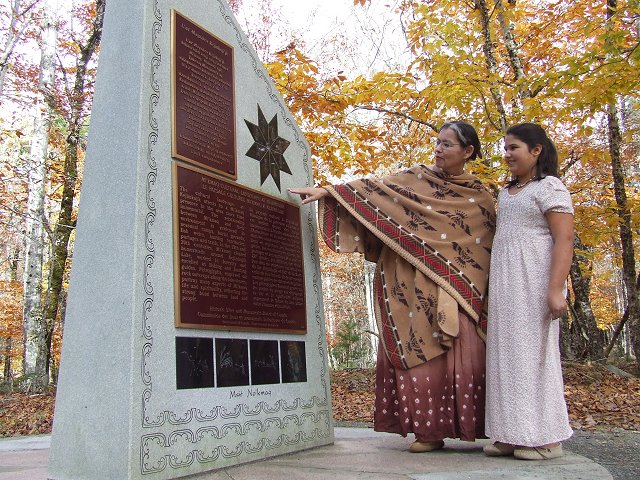 |
In 1993, Parks Canada recognized the
importance of the Mi’kmaq history represented within Kejimkujik
National Park. They formed a joint committee with the Mi’kmaq to
discuss the designation of the entire park as a landscape of
national historic significance. The following year a submission
was made to the Historic Sites and Monuments Board of Canada.
The designation was approved by the Minister in the spring of
1995, thus officially recognizing the historical value of
Kejimkujik and creating a mandate to protect this cultural
heritage. |
|
|
|
 |
Kejimkujik is certainly a park of great
beauty, and it echoes with the footsteps of ancient history.
There is no doubt that the petroglyphs hold valuable information
of the past, as they do in fact portray various aspects of
peoples’ lifestyles, their traditions, and their culture.
However, every location within the park bears witness to the
presence of the Ancestors of the Mi’kmaq. This is a place where
information was left for the next generation to receive, where
teaching and learning took place, and where connections were
made to other worlds and other times. |
|
|
|
 |
We ask all park visitors to join us in
honouring the rich heritage left to us by the Mi’kmaq Ancestors.
Walking the same secluded pathways as the Ancestors, breathing
the same rich forest air, taking in the silence that is broken
only by the sounds of nature, it is impossible not to feel a
sense of reverence for this place. So, whether you are driving
in the park, hiking our trails, or canoeing our waters, remember
that the Ancestors were here long before us, and left their
imprint upon this land. As you pass through, do so with the same
respect as the Mi’kmaq people who came this way before you. In
that way, Kejimkujik will remain a special place for every one
of us, where we can come and touch the past, in the present, for
the future. For this is where our records are… the journal of
our voyage through time. Our history, written in stone. |
|
|
|
|
Msit
no’kmaq – all my relations. |

